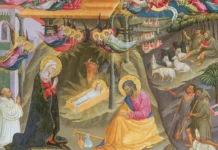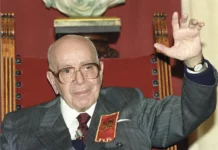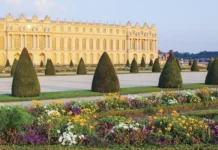In a conference, his soul overflowing with enthusiasm, Dr. Plinio described how he imagined the daily life of the Holy Family and composed a moving prayer glorifying the majesty of the Child Jesus united to suffering.
It is not unusual to find charming, venerable, worthy and dignified pictures depicting the Holy House of Nazareth, where the Holy Family dwelt. In general, they endeavour to show it with a diaphanous purity, inundated with the light of a beautifully luminous day. But there is more: a morning brightness can be observed there even late in the day, highlighting the union of an absolute simplicity with an absolute cleanliness.
Perfect cleanliness and sublime simplicity
What can be said of the cleanliness of this house?
It is difficult to imagine, because perhaps not even the Angels had the privilege of cleaning it. This was the duty of Our Lady, the Queen of Angels, and St. Joseph, her most chaste spouse. And, at times, when they were tired, the Child Himself, before all the enraptured choirs of Angels, cleaned the house so that His parents could rest.
In one corner of the room, we see a simple pitcher from which rises a lily. From its firm and upright stalk, resembling virginity and purity, a marvellous flower spreads its petals. It is the only hint of art or elegance in the entire ambience.
But looking at the place where a chair leg rests on the ground, or a shelf of unfinished wood holding three or four small objects indispensable to daily life, one is enthralled, lost for words. These sublime trifles, so common in daily life, take on a marvellous quality, bathed in that light!
The Holy Family is represented within such a décor, to very fittingly highlight the humility of persons so pure. St. Joseph, seated, is making a piece of furniture; Our Lady is doing needlework; and the Child, standing, is still so small that He braces Himself against a chair to play with two or three objects, using it as a table.
Attentive to the gestures, voice and gaze of the Child Jesus
Silence reigns. None of the three say a word, but all understand one another perfectly. In this place, the simple daily life of a labouring family coincides with the wondrous metaphysical considerations of Our Lady and St. Joseph, who live immersed in the presence of the Child, with all that this implied.
Born of the Virgin Mother, He was of David’s line, therefore, of the same stock as St. Joseph. The latter has the authentic right of a father over his Son, the fruit of his wife’s womb. But Jesus was begotten by the Holy Spirit in the virginal womb of Mary, the flower of humanity!
What can be said of this reality? There are no words to sufficiently describe it!
The Most Holy Trinity was “moved”, so to speak, to behold the least movement of the Child. Even when playing with some little stones or any other object, He was contemplated by all the Angels of Heaven. Nevertheless, His infancy unfolded in accord with the order that God placed in human nature, even though the Child-God, Son of the Virgin Mary, and conceived without original sin from the first instant of His being, was so noble and far removed from original sin.
Accordingly, we can imagine Him in the common scenes in the life of a child, such as looking for some object. At a certain moment, He would wonder where it was and, before being able to find it, seek unsuccessfully in different places, either because Our Lady or St. Joseph had moved it, or because the little cloth He was looking for had been blown away by the wind without His noticing it.
What effect would these episodes, apparently so simple, have on the relationship between the three Persons of the Blessed Trinity?
Again, St. Joseph and Mary Most Holy must have attended to their domestic duties while seeking, as far as possible, not to miss a gesture of His, always attentive to the sound of His voice, as beautiful as an ineffable melody.
A fleeting gaze of the Child Jesus was a priceless treasure; the least of His movements was endowed with inexpressible majesty and grace! They knew that it was the God-Man who was looking, walking about and speaking… We can only imagine the boundless enthusiasm that inundated them!

What would daily life together have been like in the Holy Family?
There also must have been moments when, due to the practical demands of life, they would have had to turn their attention from the Child to tend to some everyday task. Then, turning their eyes to Him once again, they would notice something unexpected in His behaviour. They would certainly have commented on it between themselves, in low tones, and if one of the spouses were outside the house at that moment, they would have received with awe the report from the other upon arriving home.
On other occasions, it was the Child Jesus who would go to play outside with another child, while St. Joseph and Our Lady remained inside exchanging thoughts: “What might our Son be doing?” They knew He was not merely satisfying the childish desire to amuse himself with a playmate, for everything He did had profound significance.
All in all, what would the relationship between the three of them in the House of Nazareth have been like? Was there a type of interlocution among them which at every moment made reference to the divine nature of Jesus? And would the Child make reference to the fruitful virginity of His Mother and the miraculous virginity of St. Joseph, flourishing in a chaste marriage? Or would these be themes that were known and venerated, but little spoken of, usually left implicit and conversing about them only on special occasions, when extraordinary lights came down from Heaven?
Except for moments in which, while contemplating the Child, the Holy Couple experienced mystical ecstasies, perhaps the remainder of the time was spent in a common life, typified by routine matters:
— Joseph, my husband, was it you who opened the door? Are you planning to leave with that bench you finished making, or will you be staying here?
— My Lady, I have to stay here some time longer, unless you wish otherwise…
Some time later, St. Joseph would say:
— My Lady, you were musing – knowing quite well that She had been conversing with the Angels! – and lunch has been on our little stove for quite some time; do see if it is ready…
We could go on imagining similar scenes…
Shining as on Tabor
I am inclined to think that, amid the wonders of this family life, a series of diverse situations would unfold simultaneously. However, everything would harmonize in accordance with a marvellous formula, of which we are unaware, but about which we may speculate.
There must have been times of extraordinary seriousness, of sublime gravity, in which the Blessed Trinity manifested itself to the Holy Couple. There must also have been moments in which that Child – who, as an adult, shone so brilliantly between Moses and Elijah – would come to them with exceptional luminosity, asking permission to go and play outside. Moments would elapse without their being able to respond, while Jesus, resplendent, awaited the parental leave. They had been transported to another realm, for they were before God!
After having contemplated such splendour, they may not have even exchanged a word about it. Mary, turning to Joseph might have said:
— It is getting late isn’t it? I will go and bring in the clothes from outside.
And he would reply:
— And I, my Lady, need to finish the piece that was ordered this afternoon.
While she went out to take in the clothes, the piece of wood that Joseph was working on quickly took the shape he intended. When she returned, Our Lady saw the finished piece and said:
— My Lord, the piece is finished so soon? – expressing her intuition that it had been finished by the Angels.
And he would discreetly respond:
— My Lady, sometimes things go quickly…
Times that prefigured the Passion and the Kingdom
There is one nuance in this coexistence of the Holy Family that I do not see reflected in iconography, and can I understand why, because it is not easy to depict.
In the Holy House of Nazareth, everything was imbued with respectability, majesty, an august seriousness and a firm decisiveness. And, above all, a disconcerting seriousness and sorrow.
At times, the Child must have suddenly appeared before the Holy Couple covered with wounds from head to foot, crushed by suffering, and carrying two small pieces of wood on His shoulders. It was a prefiguration of the Cross. It broke their hearts to see Him like that, walking back and forth resolutely, or making gestures to the Eternal Father in scenes foretelling the Agony in the Garden. What sorrow, what nobility, what majesty!
At other times, He appeared as a King, manifesting within Himself a grandeur in comparison with which the Roman Caesars seemed like street urchins. And thus we can imagine expressions of the august venerability.

Thou art every grandeur and magnificence!
Few souls are able to abide suffering. Rarer still are those who do not grow tired of admiring majesty. Nevertheless, those who have an entirely upright soul would kneel before the grandeur of such scenes and say:
“O divine majesty, how I sought Thee without knowing that it was Thee I sought! How I desired Thee! How I have endeavoured to gather the vestiges of majesty that crossed my path, and paused to contemplate in them a grandeur that I did not yet know!
“But at last, O Majesty, I have found Thee! Majesty, I understand Thee! Thou hast dominion over the Angels! In Thee dwells all grandeur!
“When Thou appearest before me, I think of the roar of powerful waterfalls which, nonetheless, are like trickling faucets in comparison with Thee. The ocean is like a thimble of water in Thy presence, and magnificence of the whole earth is as nothing compared to Thee.
“O Majesty, how I have sought Thee! O homeland of my soul, at last I have found Thee!
“When I gazed upon the Church and enthusiastically renewed my act of faith, I did not know that one of her names was ‘Majesty’. Now I understand. The Holy Roman Catholic and Apostolic Church is the receptacle of Thy majesty, the vessel of Thine honour!
“If I were to see Mary, what majesty! If I were to see Joseph, the humble carpenter, what majesty! If I were to see the Child, my soul would seek verses to celebrate Thee, O Majesty!
“My arms would yearn for a shield and a sword to defend Thee! My entire being would ready itself for the possibility of proclaiming Thee to men, O Majesty!
“It is precisely because I understand Thee, O Majesty, that I also understand that everything else is contained in Thine immensity. There is no paternal or maternal love, no fraternal affection, nor friendship, nor assistance, nor protection, nor anything of what the human heart is able to produce of kindness and tenderness that does not dwell in Thee, O Majesty! Thou art all grandeurs, all magnificence, even in the smallest things.
“Thou art my repose when I am tired; the tranquillity and the harmony of my sleep; the joy of my awaking.”
In the sanctuary of majesty, at the foot of the Cross
Who understands majesty in this way? Who perceives that in the very centre of its incommensurable sanctuary, there is an altar destined to offer suffering?
It is there that we must offer that form of spiritual sorrow which is asceticism, by which man abandons that which is frivolous, superficial and futile, and turns toward what is serious and profound. The mind strives to attain the truth; the body and soul seek the good and the beautiful, in a holocaust repeated a thousand times in this search for truth, goodness and beauty.
Without this sorrow, for us, conceived in original sin, the infinite sanctuary of majesty would have no meaning. This is the truth: sorrow is always present in our life; there is always the cross, the sacrosanct Cross of Our Lord Jesus Christ.
Who loves sorrow? Who loves the cross? Nevertheless, the link between majesty and the cross is such that, at a certain point in Christian history, no crown was made without a cross on its top. This represents the peak of majesty, and the fact that it is relatively small in relation to the crown suggests such a degree of superiority that it is difficult to comprehend. This is the majesty of the cross!
Who will love these reflections? Who will become accustomed to living with them? Who will wish to dwell in the sanctuary of majesty, kneeling at the foot of the Cross? ◊
Taken, with adaptations, from “Dr. Plinio” magazine.
São Paulo. Year XVII. N.201 (Dec., 2014); p.18-21







